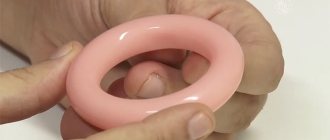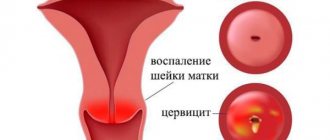Design Features
The obstetric pessary appeared in gynecology not so long ago, but has already shown high effectiveness when used and has proven itself to be an excellent “assistant” when carrying a child. It covers the cervix and prevents its premature opening, which helps redistribute the load and reduce the pressure of the embryo on the uterus.
Previously, to strengthen the cervix, stitches were placed, and the operation was performed under general anesthesia, which could lead to negative consequences and complications. It was thanks to the use and wearing of a pessary that it was possible to maintain pregnancy in 90% of women.
Unloading rings are made from non-allergenic and completely safe materials, for example, special plastic or silicone is often used to make them. These materials have flexibility and elasticity, which helps them adapt well to the required size. At the same time, pessaries have the necessary strength and density.
Most often, rings are disposable with a certain shelf life. The unloading ring is removed at 38 weeks of pregnancy, which provokes relaxation of the cervix and quickly leads to the onset of labor. If amniotic fluid ruptures before the scheduled time, the pessary is urgently removed.
Installation Rules
For reliable installation, the pessary must have several support points. Most of the obstetric ring is attached in the rectum area, the smaller part is adjacent to the pubis. The ring, which is placed in the center, targets the cervix and prevents it from opening. Other holes in the pessary are intended for the normal discharge of vaginal discharge.
Due to the fact that all the edges of the ring are well processed and rounded, there is no trauma to the mucous membranes of the genitals, and the woman also does not experience any discomfort when wearing a pessary.
Indications for use and contraindications
In order to install an obstetric ring, there are certain requirements:
- Presence and prevention of development of isthmic-cervical insufficiency (ICI).
- As a precaution if a woman has had miscarriages in a previous pregnancy.
- Weak walls at the cervix.
- Multiple pregnancies.
If there is a threat of premature birth or miscarriage, the retention ring will help preserve the pregnancy and make it possible to wait until the due date.
The gynecological pessary has contraindications for use:
- The presence of recurrent bleeding (2nd and 3rd trimesters of pregnancy) from the genitals.
- High degree of ICN.
- Possible termination of pregnancy, due to the presence of certain diseases in the woman.
- Intrauterine infection of the fetus, its death.
- Cases of frozen pregnancy.
- Inflammation of the female genital organs or genitals.
- The appearance of bloody spotting from the genital tract (of unknown etiology).
There is no need to worry that the obstetric ring will lead to the development of disorders or diseases; this device will not cause any harm to either the expectant mother or the fetus.
What does discharge after installation of a pessary indicate: bloody, brown
The appearance of discharge after installation of a pessary is possible both normally and as a sign of pathology. From this article, readers will learn what should be and what is a symptom of a dangerous condition.
Sometimes situations arise in which it is extremely difficult to maintain a pregnancy. The cervix relaxes and begins to dilate long before the expected due date.
Previously, in order to leave the child in the womb, sutures were placed that restrained the expansion of the cervical canal. Today there is a safe obstetric invention - a pessary.
Its appearance can be different: a cube with a recess in the shape of a hemisphere, a ring, a “doughnut”, a circle with a bulge, an oval. This choice helps to find a remedy based on the characteristics of the anatomical structure. Latex or special plastic is used for manufacturing.
The pessary is made in such a way that it all has smooth rounded shapes to prevent injuries to the mucous membrane of the vagina and cervix. There are three sizes: for nulliparous women, after 1-2 pregnancies, and for mothers of 3 or more children.
Attention! One of the best pessaries is considered to be the “Doctor Arabin” brand produced in Germany.
You can introduce such a limiter at any time, but more often this happens after 20 weeks. The procedure is quick and performed without pain relief. The sensations when placing the device are individual; there is a feeling of fullness and discomfort, and sometimes some pain.
After proper installation, the woman almost does not feel it.
The pessary is located at an angle, the upper edge is at the back wall of the vagina, the lower edge is behind the pubis. The neck is fixed. As a preparation, the genital organs are sanitized either with suppositories several days in advance, or with antiseptics immediately before the procedure.
A pessary is needed in the following situations:
- Multiple pregnancy;
- Isthmic-cervical insufficiency;
- The patient has a history of miscarriages;
- Decreased cervical tone, dilatation.
Discharge when wearing a retaining ring
Installation of a foreign body in the vagina, i.e. disruption of the integrity of the reproductive system, can cause infection, as well as exacerbation of hidden or chronic diseases.
Often the presence of a pessary leads to more intense discharge. This may be due to increased secretion in the gonads (normal) or the occurrence of pathologies in the woman’s genitourinary system (deviation).
A woman should immediately consult a doctor if unusual discharge appears during the pessary or if its character changes:
- The discharge is brown in color and also mixed with blood. Ichor sometimes appears after the installation of an obstetric ring. If such discharge appears while wearing a pessary, you should consult a gynecologist.
- Presence of yellowish or greenish discharge. Characterizes the presence of a bacterial infection in a woman. This condition requires treatment; in difficult cases, you even have to remove the ring (if there is no result from the therapy).
- Watery, copious discharge that is odorless and colorless. This is a kind of “signal” about a possible violation of the integrity of the amniotic sac; an urgent consultation with a gynecologist is needed.
- The presence of discharge, which is accompanied by itching or irritation in the vaginal area, which is associated with the development of colpitis.
After installing a pessary, a woman is recommended to undergo a smear every 2-3 weeks for bacteriological examination.
A large amount of mucous discharge can provoke removal of the pessary; this is due to the waste of cervical mucus that has accumulated while wearing the device.
Important! Do not panic if discharge appears after installing a pessary; this phenomenon is understandable and normal.
The body thus seeks to eliminate the foreign body. If you want to dispel all doubts, purchase a special test to determine possible leakage of amniotic fluid.
Discharge during pregnancy with a pessary: when to sound the alarm?
The period of waiting for a baby is the most important and long-awaited period in a woman’s life. Most pregnancies in the fairer sex proceed without pathologies, and the body copes with everything on its own, but sometimes there are situations when it needs outside help.
For example, when there is a threat of premature birth, women are often fitted with a pessary. The practice of introducing this device into the body is quite young and is accompanied by many questions.
What is it, and what kind of discharge with a pessary may occur during pregnancy, this article will answer.
Features of using a pessary during pregnancy
The use of a pessary has been used in obstetrics and gynecology not so long ago. Nevertheless, this practice is quite successful and is gaining momentum.
A pessary is a so-called “obstetric ring” that is installed at the entrance of the cervix in order to redistribute the fetal pressure on it.
As a rule, this device is used when the cervix is too short, is weak and threatens premature dilatation, has increased tone, or to facilitate bearing two fetuses at once. The main indication for its use is isthmic-cervical insufficiency.
The installed device consists of rings made of plastic and silicone with an absolutely smooth surface, which are inserted and placed inside quite easily and painlessly. This procedure is carried out after the 20th week of gestation, and is removed after the 38th week. Then, generally within a week, labor begins.
What kind of discharge with a pessary during pregnancy is normal?
Obviously, such an object is a foreign body for the body, so discharge after installation of a pessary is quite justified.
The gonads, in response to the invasion of a “foreign” body, begin their active work, secreting an excessive amount of mucous secretion in order to protect against foreign organisms.
Normally, discharge from a pessary should be transparent, fairly moderate, not have an unpleasant odor and have a uniform sticky consistency.
Transparent mucusLike protein
Sometimes brown discharge may be observed during pregnancy, light or spotting. This happens if doctors have placed the pessary carelessly and damaged small vessels. In this case, the mucus will be insignificant, odorless and uniform in texture.
BrownishIronic
If such phenomena continue for several days in a row and do not slow down, this may indicate damage to the mucous membrane, injury to the genital organs as a result of improper insertion of this device.
Excessive bleeding is a reason to immediately seek medical help.
Do not be alarmed if you notice discharge after removing the pessary. This may be the natural release of a mucus plug, which precedes the onset of the labor process. Or it is the discharge of mucus that has accumulated while the device was inside.
What discharge is dangerous when using an obstetric ring?
It is worth noting that the mere placement of a ring on the cervix contributes to the exacerbation of certain infectious, fungal or bacterial diseases. Therefore, if before its introduction there was a problem such as thrush or bacteriosis, the number of isolated manifestations will certainly increase, and the disease will make itself felt.
If the discharge after the pessary is brownish, or bleeds a little and stretches in the lower abdomen, this may indicate fetal fading or a threat of miscarriage. In this case, you should immediately contact a specialist.
Bloody mucusBrown with mucus
Liquid white discharge, cheesy with an unpleasant odor, may be a manifestation of Candidiasis. In this case, the ring is removed until the thrush is completely eliminated.
Curdled secretion for thrush
If the mucus is characterized by yellow or green tints and an unpleasant odor, this may indicate an infectious, bacterial or viral disease. In such cases, the device is often removed, the disease is completely treated, and then the specialist, after conducting diagnostics, decides whether to reinstall it or not.
Purulent with vaginitisPurulent
Watery discharge in the late pregnancy - mucous liquid in large quantities without color is caused by leaking water, rupture of the placenta, which poses a great threat to the unborn child and mother. In this case, you should immediately consult a doctor.
Watery Smoothing creamy
Reviews from women and specialists
Recently, more and more specialists have resorted to using a pessary if uterine tone, cervical weakness is detected, or to support it during a twin pregnancy. This method is safe, quite easy to implement and shows good results (78% of successful full-term pregnancies with a threat of miscarriage).
Experts say that the appearance of discharge is a natural process that accompanies the placement of an obstetric ring, since the body at this moment begins to produce more sexual secretion in order to create a barrier in response to the appearance of a foreign body. In some cases, along with the placement of the device, doctors prescribe the drug “Utrozhestan” to relieve uterine tone.
Along with the specialists, patients also leave positive reviews.
Taking cues from Western female representatives, our compatriots, compared to 2014 (the beginning of the spread of the use of pessaries in the CIS countries), began to resort to this method 3.5 times more often.
Since placement mainly occurs at week 20, by this time the diagnosis and tests have been completed and all diseases have been cured. Accordingly, few people encounter pathological discharge when using an obstetric ring.
Take good care of your body during pregnancy and be healthy!
Similar posts on the topic “Discharge and pessary. "
Discharge during pessary
Children's allergies: what does mom need to know?
What were you doing at 2 years old?
Children in cages. how they walked kids in London in the 30s
Discharge during pessary
Discharge during pregnancy. For myself, and if anyone is interested
The process of bearing a child requires from a woman not only physiological and psycho-emotional commitment, but also a certain responsibility. Pregnancy does not always proceed smoothly and as the expectant mother would like.
There is a list of unfavorable factors that can cause premature onset of labor or spontaneous termination of pregnancy.
One of these conditions is isthmic-cervical insufficiency, which acts as a direct indication for the installation of a pessary. This specialized device helps to evenly distribute the load that the growing fetus puts on the uterus.
Discharge during pessary (like water, orange, watery, brown) abundant – reasons
There are many factors and pathologies in which the entire period of pregnancy remains at an increased risk of premature opening of the cervical canal and the onset of labor. Because of this condition, many women could not bear and give birth to a child for a long time.
Relatively recently, a special obstetric device was invented - a pessary. Although there is a characteristic discharge for some time after it, the device has allowed many women to successfully bear healthy children.
Previously, surgical suturing of the uterus was used instead of this device. However, such measures were very painful, were carried out under anesthesia and had unpleasant complications. The ring installation procedure is much simpler and only takes a few minutes. It is carried out in a gynecological chair and is not considered a surgical intervention.
Definition
A pessary is a specialized obstetric and gynecological device, shaped like a tight ring, which is installed in pregnant women in the cervical canal area. With a pessary, a pregnant woman is not at risk of premature opening of the cervical canal.
In obstetric and gynecological practice, this device is very popular, as it helps to avoid premature onset of labor in many women.
Before the invention of this product, obstetric practice used the technique of suturing the cervix, which prevented its premature dilatation. This procedure was accompanied by pain, so it was performed under general anesthesia.
Installation of the pessary takes several minutes and is performed on an outpatient basis. These devices come in oblong, oval or round shapes. Their installation is completely painless and is not accompanied by significant discomfort. Each pessary is made from hypoallergenic materials with high strength and elasticity.
Indications
Installation of a special ring on the cervix may be recommended for pregnant women with the following conditions:
- In case of multiple pregnancy;
- If there is a gynecological history of miscarriage;
- For isthmic-cervical insufficiency;
- In case of diagnosing reduced tone of the cervical canal.
Each of the listed conditions is a direct indication for the installation of a pessary. Despite all the benefits, this procedure is contraindicated for some women. Conditions that prevent the installation of a pessary include:
- Advanced course of isthmic-cervical insufficiency;
- Frequently recurring uterine bleeding in the 2nd and 3rd trimester of pregnancy;
- Frozen pregnancy;
- Intrauterine fetal death;
- The presence of autoimmune pathologies in the expectant mother, as well as diseases that are indications for artificial termination of pregnancy;
- Infectious and inflammatory damage to the organs of the reproductive system;
- Placental abruption.
In the absence of contraindications, a pregnant woman can safely trust specialists, as this safe device will help maintain pregnancy and give birth to a healthy baby.
Discharge
After a woman has had this device installed, she may notice a change in the nature of discharge from the genital tract. Copious discharge and a pessary are the norm.
80% of pregnant women who undergo pessary placement experience an increase in the volume of clear or white mucous discharge from the vagina. This physiological reaction indicates that the woman’s body normally accepted the introduction of a foreign body.
The increase in the volume of discharge is due to the fact that the glands located in the vagina and cervical canal begin to accelerate the production of mucous secretion. Such changes can be observed not only after installing the product, but also after its removal. The following signs indicate that the female body has responded normally to the installation of a pessary:
- No itching or burning in the external genital area;
- There is no pain or discomfort in the vagina;
- The discharge does not change color and is not accompanied by an unpleasant odor;
- A pregnant woman does not feel nagging pain in the lower back and lower abdomen;
- The discharge does not contain pathological impurities and is transparent or white.
If, after installing the pessary, the discharge does not meet one or more of the listed criteria, then the expectant mother is advised to consult a medical specialist.
Pathological
Those women who have undergone the installation of this device are advised to pay attention to the nature of vaginal discharge. We can say that the discharge is pathological in nature if it looks like this:
- Yellow with patches of pus. Such pathological discharge is often accompanied by an unpleasant odor, burning sensation and itching in the external genital area. Such symptoms indicate the development of an infectious-inflammatory process provoked by bacterial microflora. Without proper treatment, a pregnant woman risks facing dangerous complications.
- Bloody, brown or brown. These discharges are considered normal only if they are present on the first day of pessary installation. The appearance of this symptom a few days after the procedure indicates serious complications (placental abruption, erosive and ulcerative lesions of the cervix, neoplasms).
- Pink or yellow, accompanied by pain and discomfort in the vagina. Such discharge can be provoked by an inflammatory process localized to the vaginal mucosa.
- Watery, transparent, odorless. Such discharge with a pessary in late pregnancy indicates the onset of labor and the discharge of amniotic fluid. For pregnant women in this condition, emergency removal of the pessary and constant monitoring are recommended. In the early stages of pregnancy, this symptom indicates a violation of the integrity of the amniotic sac with subsequent leakage of fluid. This condition is equally dangerous for both mother and child. Regardless of gestational age, copious watery discharge from the genital tract is an indication to consult a doctor.
In order not to miss the development of complications that arise during the installation of a pessary, medical experts recommend that pregnant women undergo regular examination, which includes bacteriological analysis of vaginal smears.
Any pathological discharge after removal of the pessary is an absolute indication for a comprehensive examination of a pregnant woman. If the expectant mother suffered from one of the chronic diseases of the reproductive system before pregnancy, then the installation of this device may provoke an exacerbation of the disease.
Despite the existing risks, a pessary remains the only effective way to avoid miscarriage or premature onset of labor in certain conditions.
«>
Discharge after installation of a pessary during pregnancy: causes
If the cervix is unable to hold a pregnant woman's uterus in a normal position, there is a risk of miscarriage. To save the child and help the woman successfully carry it, the gynecologist may recommend installing a pessary.
After insertion of the pessary, discharge may appear. We will tell you how to distinguish normal from pathological ones in this article.
What is a pessary and why is it used during pregnancy?
A special device made of plastic or silicone, which is inserted into a woman’s vagina to support the internal organs of the small pelvis, is called a pessary in obstetrics and gynecology. The pessary has a ring shape. Its installation is indicated for expectant mothers suffering from isthmic-cervical insufficiency, as an addition to drug therapy and/or surgical correction.
Discharges after device installation
Installing the pessary takes less than 1 minute, but the woman will have to prepare for unpleasant sensations. In addition, pregnant women diagnosed with ICI have to wear the device until delivery, so they will have to get used to it willy-nilly. When the obstetric ring is installed, the woman may notice the appearance of discharge - normal or pathological.
Normal discharge
A normal reaction of the body to a plastic or silicone ring installed in the vagina is an intensification of mucus production. In this way, the body seeks to get rid of the foreign object and protect itself from the possible penetration of pathogenic microorganisms. You can determine that the discharge remains within normal limits by the following signs:
- the pregnant woman does not feel pain in the abdominal area;
- discharge of moderate thickness, translucent, odorless;
- The pessary does not cause discomfort or unpleasant sensations.
Regarding the absence of discomfort when wearing a pessary, it should be clarified that in the first days after its installation, a woman will feel some discomfort (often caused by psychological reasons). However, after 2-3 days, if the ring is installed correctly, addiction occurs, and the device is absolutely not felt in any normal body position (sitting, lying, standing, walking).
Pathological discharge
Installation of a pessary is a form of intervention in the normal functioning of a woman’s reproductive system.
Sometimes the doctor makes a mistake when installing the ring, which can lead to unpleasant consequences, but even if the obstetrician-gynecologist did everything correctly, a foreign object can provoke a negative reaction from the body, including the development or exacerbation of diseases of the pelvic organs.
Normally, small amounts of dark or brown “smudge” should disappear within 48 hours. If the third day has passed and the discharge still contains traces of blood, you should urgently consult a doctor, as this is a symptom of injury or damage.
Sometimes the installation of a pessary is supplemented by the application of special sutures to the cervix. This measure allows you to increase the reliability of maintenance “therapy” and is actively used for isthmic-cervical insufficiency. After suturing, the intensity and duration of bleeding may be greater, so the woman is in the hospital under observation for a week.
The appearance of watery discharge, transparent, odorless and colorless, is an alarming signal. There is a high probability that the amniotic sac has been damaged and the woman is leaking amniotic fluid. This is a dangerous condition that threatens the life of the fetus, so you should immediately call an ambulance: they can only help a pregnant woman in a hospital setting.
Yellow or greenish discharge after insertion of a pessary, which has a strong unpleasant odor, is a symptom of the disease.
Installing a ring can lead to the development of an infectious disease (especially if a woman neglects the doctor’s recommendations and does not use antibacterial vaginal suppositories) or cause an exacerbation of an already established disease. In any case, urgent diagnosis and treatment is needed.
Discharge after device removal
If a woman tolerates the installation of an obstetric ring normally, she does not experience pain, and there are no pathological discharges, then she will have to wear the ring all the time until the 37-38th week of pregnancy. The ring is removed as quickly as it is put on. Labor usually begins shortly after the device is removed. The pessary can be removed earlier than the specified period for the following indications:
- labor has begun;
- leakage or rupture of amniotic fluid (may indicate the onset of labor);
- diagnosed infectious lesion of the amniotic sac;
- development of infectious disease of the pelvic organs;
- extreme need for urgent delivery (becomes a consequence of identified pathological processes in the mother’s body, pathologies of the fetus, etc.).
Before removing the ring, the doctor must examine and interview the patient. When considering early removal of the device, the doctor takes into account the above indications. Removing the ring to treat the infection may be temporary - then after eliminating the problem, you can put in a new pessary, if the need to wear it has not yet disappeared.
https://www.youtube.com/watch?v=CF0zRABAU_E
Discharge after removing the pessary can also bother a woman. Within 24 hours after the procedure, a slight admixture of blood may appear in them; this is a normal reaction of the mucous membrane to mechanical stress. If spotting persists longer, this is a reason for an urgent visit to the doctor.
Typically, labor begins 1-1.5 weeks after removal of the support device or even a little later. However, it happens that labor begins almost immediately after the pessary is removed. For this reason, a pregnant woman should pay close attention to the nature of the discharge. Removal of the mucus plug and copious watery discharge are signs of labor beginning.










